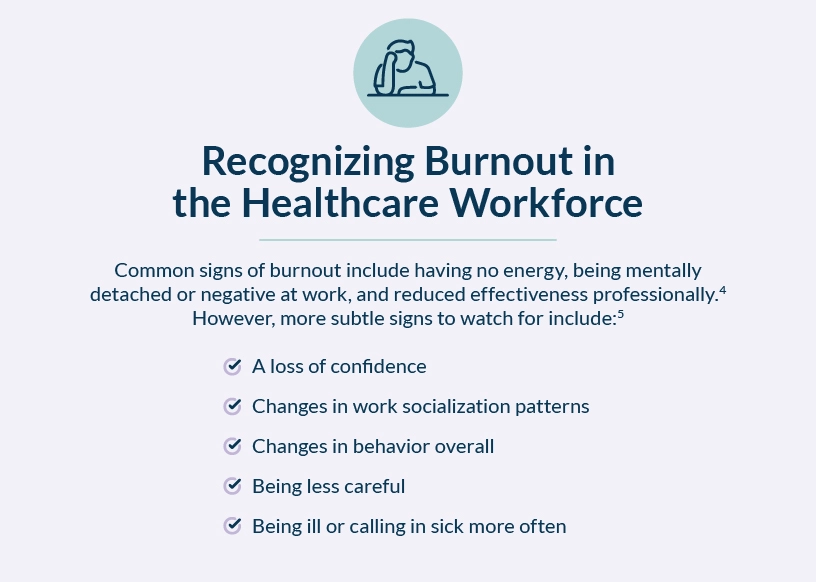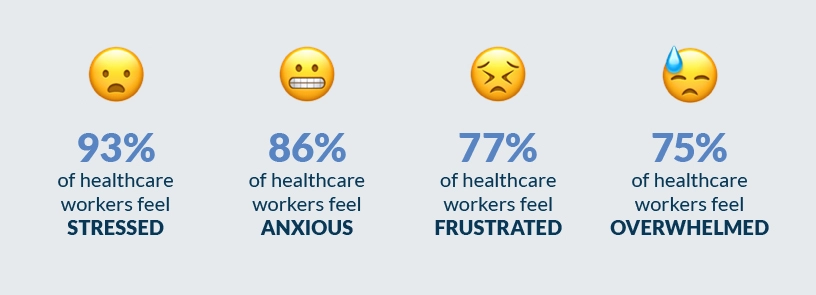From Burnout to Balance: How to Support Our Healthcare Workers Through a Culture of Care

Nearly one in two healthcare workers (46%) said they feel burnt out often, with almost the same amount (44%) reporting that they intended to look for new work.1 While some call on systemic changes to reduce burnout and ease its effects, others suggest this is an incomplete approach, stating “we must fix both the system and help the people in need who suffered from that system.”2 In short, we must help our healthcare workers.
This reinforces the need for healthcare organizations to find ways to reduce worker burnout, which can help improve employees’ mental health and may even promote their longevity in this field. It can even benefit society as a whole.

Why Addressing Health Worker Burnout Is So Important
The U.S. Department of Health and Human Services (DHS) shares that the effects of health worker burnout are extensive.3 Workers themselves face strains within multiple aspects of their well-being: physically, emotionally, and psychologically. This can affect their job performance and potentially cause them to leave the healthcare workforce entirely, both of which place strain on employers. Even patients feel the effects of health worker burnout as it becomes more difficult for these staff to provide a higher level of care.
The DHS adds that if we don’t find ways to effectively address this issue – which it says is at a crisis level – the result is likely higher healthcare costs and worsened disparities. This impacts society by reducing the accessibility of healthcare, and making it harder for health organizations and systems to adequately prepare for future public health emergencies.
When our healthcare workforce is burnt out, everyone loses. Not only the workers in the middle of these negative experiences, but also organizations, systems, and entire societies.

Benefits of Providing Healthcare Workers with Adequate Support
Healthcare worker burnout is multifaceted in that many factors can contribute to these feelings. Among them are being underappreciated and overworked while also facing heightened patient demands and expectations.6
Supporting caregivers in the healthcare field offers several benefits:
- Reducing the risk of burnout. A 2023 Qualify of Worklife Survey found that while the overall number of health workers feeling burnt out has increased, their odds of burnout decreased when they felt supported and had help from their supervisors.7
- Improving workers’ mental health. Although many healthcare workers are dealing with mental health issues, only 13% of those in frontline roles report that they’ve received treatment.8 Caring for the psychological well-being of both patient-facing and behind-the-scenes healthcare professionals is critical, especially when faced with grim statistics such as these:9

- Increasing retention rates. A survey of 43,026 clinical and non-clinical healthcare staff revealed that 28.7% intended to leave their jobs due, at least in part, to work overload and burnout.10 Implementing strategies to better support these staff and reduce their workload may help lessen their desire to leave, potentially lowering turnover rates.
- Boosting productivity. When employees feel burnt out, their productivity declines, in addition to becoming less creative and more prone to errors.11 At a minimum, this can keep important tasks from being completed in a timely matter. Worst case scenario, an error occurs – which, in healthcare, can be catastrophic.

- Enhancing patients’ experiences. Burnt out healthcare staff can be distant and cold to patients, increasing the risk of a poor patient experience and leading to more complaints.13 Developing strategies to keep employees from experiencing burnout can help prevent this negative response, providing a better patient experience.
Finding ways to support healthcare caregivers tells them that, while they may be busy caring for others, their employers care about them. This can be accomplished by creating a culture of care.
What Is a Culture of Care?
A culture of care in an environment where employees feel valued and supported. It lets them know they are appreciated, and that there are people within the organization they can call upon if they’re facing challenges. It is respectful, compassionate, considerate, and civil.

An article published in the journal Social & Cultural Geography provides a succinct, yet effective way to think about this type of environment. It explains that a culture of care is a “culture with care.”15 It is a culture in which care is active; it is a verb versus a noun.
Making care a foundational principle can help healthcare organizations address some of the factors known to contribute to burnout, such as reducing feelings of underappreciation. It may also ease burnout’s effects by providing workers with support when facing higher workloads and patient demands. But how do you create this type of culture?
How to Create a Care-Forward Workplace
Several steps can be taken to promote care within healthcare workplaces. Here are some to consider.
Prioritize Employee Well-Being
Create a workplace environment in which it’s clear that employee well-being is a top priority. The American Psychological Association offers advice as to how to do this:16
- Conduct regular surveys to measure worker burnout.
- Keep in contact with workers to assess how they’re doing, track their workloads, and encourage them to take time off.
- Evaluate your current practices to ensure that workers are given the ability to manage their workload and job-related stress.
Provide Adequate Resources
Workers in allied health roles can face several demands – from employers, managers, and patients. If these demands increase without also increasing the staff’s access to resources, the strain on the workers goes up as well, which negatively affects their well-being.17
Resources provided may include giving employees access to mental health programs or treatments. They could also involve training managers to build trust with their teams, promote worker mental health, provide productivity support, and reinforce a workplace free from harassment.18
Build Diverse Teams
A culture of care is welcoming to and accepting of people from different backgrounds. It encourages and celebrates diversity, equity, and inclusion (DEI) while – at the same time – discouraging or having zero tolerance for prejudice, discrimination, and harassment.
To build diverse teams:
- Analyze current policies, procedures, and processes to identify any biases that may exist.
- Develop a DEI strategy for recruitment, retention, and promotions.
- Help employees feel safe in discussing DEI issues or concerns.
- Provide diversity training so everyone understands its value, as well as how to support it.
Harness the Power of Positivity
Research involving healthcare workers found that using positive psychology interventions improved workers’ well-being while also reducing their feelings of depression.19 In these interventions, participants learned to recognize their positive emotions and then were encouraged to take action to bring those emotions out.
Positive psychology can also improve organizational performance.20 It does this by building on the strengths and positive qualities of personnel, helping them flourish in their positions.
Two ways to harness the power of positivity within the workplace are through mindfulness- or gratitude-based interventions as both have been associated with reductions in worker stress, depression, anxiety, and burnout.

Offer Professional Development Opportunities
Another way to address healthcare worker burnout is to offer employees access to professional development programs. These help workers find more meaning and interest in their work, also increasing their engagement.22
Other benefits of professional development in healthcare include staying up to date with the latest medical interventions and equipment, learning how to utilize technological systems and devices more effectively, and increasing the skills applicable to the job.
Nasium Training Offers Healthcare Training Courses
Nasium Training can help you train your healthcare workforce, giving them the education and skills needed to fill important roles. We offer a variety of allied health training courses, each designed with care in mind. Contact us today and let’s talk about the workforce challenges – and how providing our training solutions may help.
1 Centers for Disease Control and Prevention. Health Workers Face a Mental Health Crisis. https://www.cdc.gov/vitalsigns/health-worker-mental-health/index.html
2 Rehder K, Adair K, Sexton B. The Science of Health Care Worker Burnout: Assessing and Improving Health Care Worker Well-Being. Arch Pathol Lab Med. https://meridian.allenpress.com/aplm/article/145/9/1095/469816/The-Science-of-Health-Care-Worker-Burnout
3 U.S. Department of Health and Human Services. Health Worker Burnout. https://www.hhs.gov/surgeongeneral/priorities/health-worker-burnout/index.html
4 Mental Health America. Facing Burnout as a Healthcare Worker. https://www.mhanational.org/facing-burnout-healthcare-worker
5 Calm Business. 5 Subtle Employee Burnout Signs You Could be Overlooking. https://business.calm.com/resources/blog/subtle-employee-burnout-signs/
6 Wolters Kluwer. Insights on institutional fatigue: Combating healthcare worker burnout and improving patient care in complex environments. https://www.wolterskluwer.com/en/expert-insights/combating-healthcare-worker-burnout-and-improving-patient-care
7 Centers for Disease Control and Prevention. MMWR Morb Mortal Wkly Rep 2023;72:1197-1205. https://www.cdc.gov/mmwr/volumes/72/wr/mm7244e1.htm
8 American Hospital Association. Strengthening the Health Care Workforce. https://www.aha.org/workforce-strategies/supporting-behavioral-health
9 Mental Health America. The Mental Health of Healthcare Workers in COVID-19. https://mhanational.org/mental-health-healthcare-workers-covid-19
10 Rotenstein LS, et al. The Association of Work Overload with Burnout and Intent to Leave the Job across the Healthcare Workforce During COVID-19. J Gen Intern Med. https://link.springer.com/article/10.1007/s11606-023-08153-z
11 American Psychological Association. Employers need to focus on workplace burnout: Here’s why. https://www.apa.org/topics/healthy-workplaces/workplace-burnout
12 Rehder K, Adair K, Sexton B. The Science of Health Care Worker Burnout: Assessing and Improving Health Care Worker Well-Being. Arch Pathol Lab Med. https://meridian.allenpress.com/aplm/article/145/9/1095/469816/The-Science-of-Health-Care-Worker-Burnout
13 Agency for Healthcare Research and Quality. Burnout. https://psnet.ahrq.gov/primer/burnout
14 Freedman B, et al. The prevalence of incivility in hospitals and the effects of incivility on patient safety culture and outcomes: A systematic review and meta-analysis. J Adv Nurs. https://onlinelibrary.wiley.com/doi/full/10.1111/jan.16111
15 Greenhough G, Davies G, Bowlby S. Why ‘cultures of care’? Soc Cult Geog. https://www.tandfonline.com/doi/full/10.1080/14649365.2022.2105938
16 American Psychological Association. Employers need to focus on workplace burnout: Here’s why. https://www.apa.org/topics/healthy-workplaces/workplace-burnout
17 Rehder K, Adair K, Sexton B. The Science of Health Care Worker Burnout: Assessing and Improving Health Care Worker Well-Being. Arch Pathol Lab Med. https://meridian.allenpress.com/aplm/article/145/9/1095/469816/The-Science-of-Health-Care-Worker-Burnout
18 Centers for Disease Control and Prevention. Health Workers Face a Mental Health Crisis. https://www.cdc.gov/vitalsigns/health-worker-mental-health/index.html
19 Profit J, Adiar K, et al. Randomized controlled trial of the “WISER” intervention to reduce healthcare worker burnout. J Perinatol. https://www.nature.com/articles/s41372-021-01100-y
20 Kletter M, Harris B, Brown C. Outcomes, mechanisms and contextual factors of positive psychology interventions for health workers: a systematic review of global evidence. Human Res Health. https://link.springer.com/article/10.1186/s12960-021-00564-5
21 Townsley A, Li-Wang J, Katta R. Healthcare Workers’ Well-Being: A Systematic Review of Positive Psychology Interventions. Cureus. https://www.ncbi.nlm.nih.gov/pmc/articles/PMC9946896/
22 Rehder K, Adair K, Sexton B. The Science of Health Care Worker Burnout: Assessing and Improving Health Care Worker Well-Being. Arch Pathol Lab Med. https://meridian.allenpress.com/aplm/article/145/9/1095/469816/The-Science-of-Health-Care-Worker-Burnout
